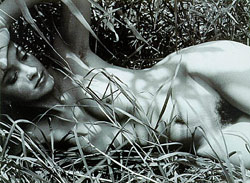 |
 |
 |
 Vallarta Living | Art Talk | May 2005 Vallarta Living | Art Talk | May 2005  
San Jose Museum of Art Exhibition Celebrates Master Mexican Photographer
 eMediaWire.com eMediaWire.com


| | Caja de visiones/Box of Visions: Manuel Álvarez Bravo is an exhibition celebrating the work of this 20th century master photographer. |
Curated by the San Jose Museum of Art’s Chief Curator Susan Landauer, Caja de visiones/Box of Visions: Manuel Álvarez Bravo is an exhibition of approximately 50 black-and-white photographs celebrating the work of this 20th century master photographer. On view from June 19, 2005 through September 11, 2005 at the San Jose Museum of Art (SJMA), the exhibition highlights work that Álvarez Bravo produced in Mexico from the 1920s through the 1940s, and includes a selection of well-known major works as well as lesser known photographs that have been rarely exhibited. Colette Álvarez-Urbajtel, Álvarez Bravo’s wife, is expected to attend the opening reception at SJMA on June 18.

At once powerful and lyrical, Álvarez Bravo’s photographs capture the soul of his native Mexico. A prominent figure who often explored the surreal worlds of fantasy, mystery, spirituality, and the metaphysical, it was his love of Mexico that ultimately lay at the heart of his work: "My calling is with Mexico's exterior, or rather with capturing that exterior to explore all the complicated layers beneath it."

Alongside painters Diego Rivera and José Clemente Orozco, Álvarez Bravo played a leading role in the artistic renaissance that flourished in Mexico after the Mexican Revolution of 1910-1920.

His work achieved international stature in 1939 when French poet and critic André Breton—the leader of the Surrealist movement—featured Álvarez Bravo’s photographs in an exhibition at the Galerie Renou et Colle in Paris. Álvarez Bravo’s work fit Breton’s definition of Surrealist art, although the artist always resisted attempts to annex him into any –ism or movement.

Álvarez Bravo was a friend and peer of several notable modernist photographers who lived and worked in Mexico, including Edward Weston, Tina Modotti, and Henri Cartier-Bresson. And while influenced by their styles, he pursued his own path—one of intense observation, distilling the image into “emblems of experience.”

Born in 1902, Álvarez Bravo came of age during Mexico’s cataclysmic revolution (1910-1920). Against the backdrop of a post-war idealist order, Álvarez Bravo taught himself photography, and at age 21 met the noted German photographer Hugo Brehme, who had come to Mexico on assignment. Brehme taught Álvarez Bravo advanced photographic techniques and introduced him to another German-born photographer living in Mexico, the father of Frida Kahlo, Wilhelm Kahlo. Álvarez Bravo would later photograph Frida creating what was to become one of the best-known portraits of the modern era.

Never reluctant to experiment and explore different photographic styles, Álvarez Bravo became fascinated by city street scenes, signs, vendors, and storefronts. Over time, he refined his unique photographic technique to capture the contradictions between urban life and personal solitude. While the period from 1920 to 1940 is often considered to be the height of Álvarez Bravo’s career, he continued to produce powerful photographs throughout his lifetime. Álvarez Bravo died on October 19, 2002 at the age of 100. | 
 | |
 |



